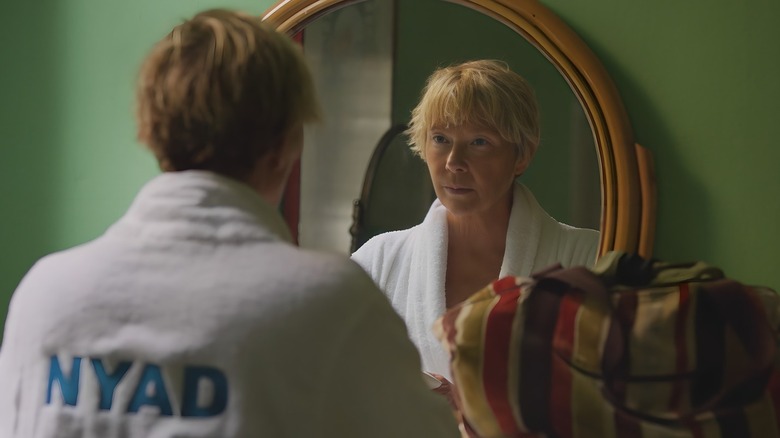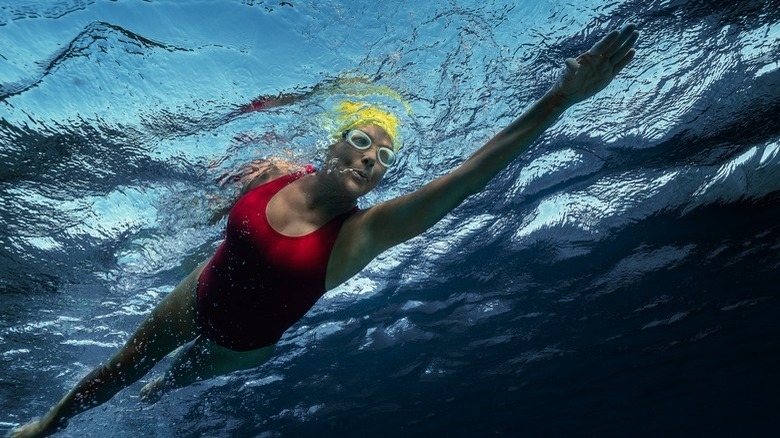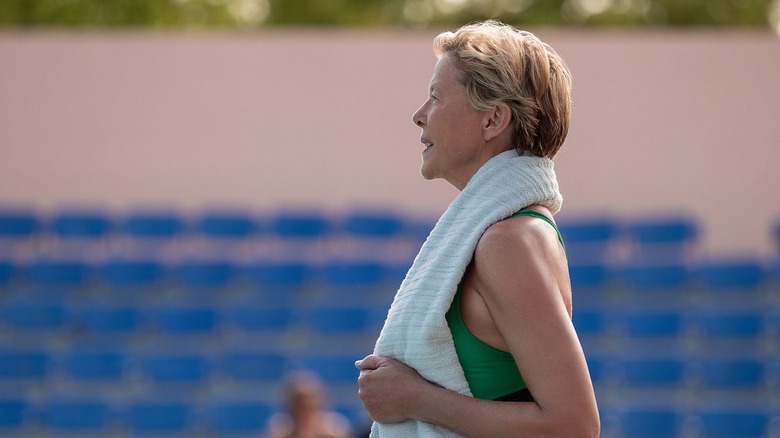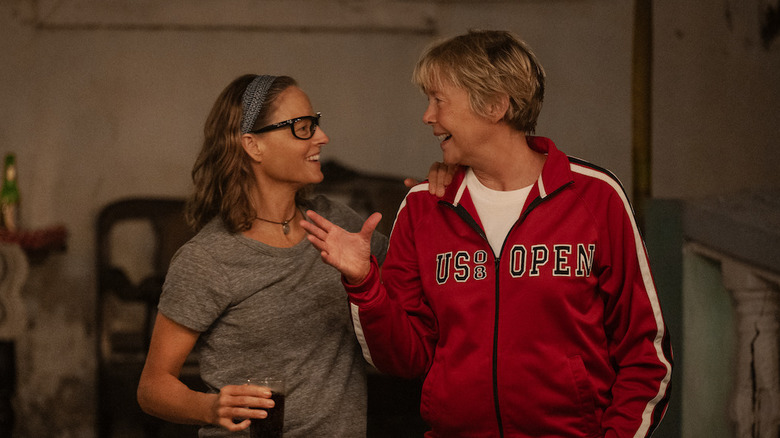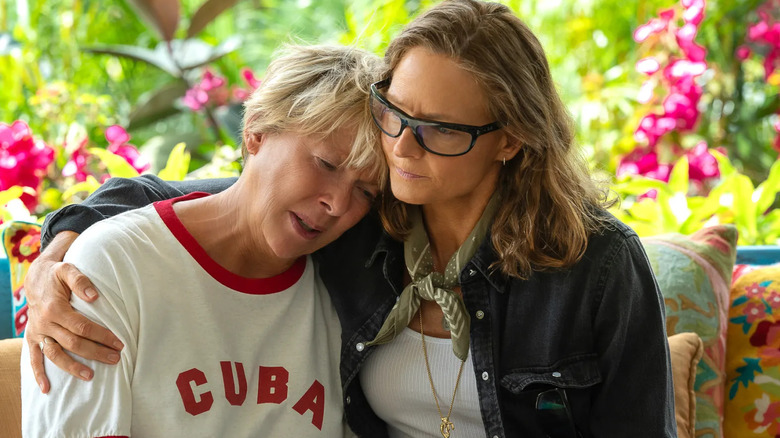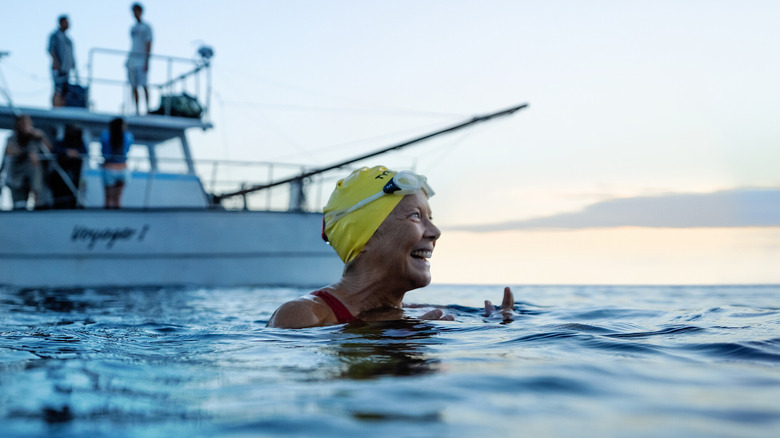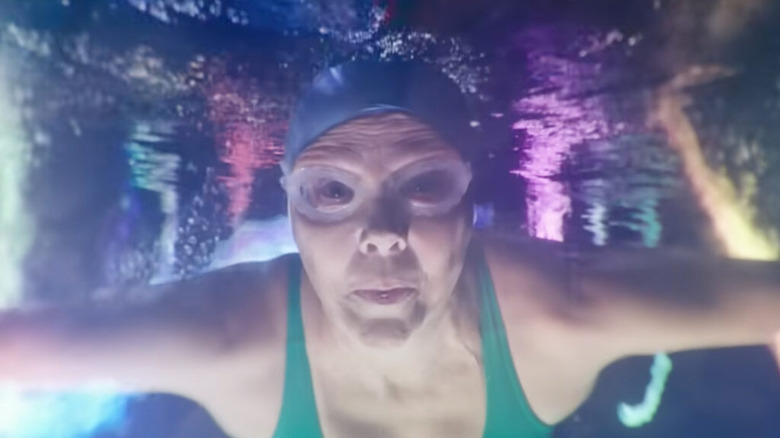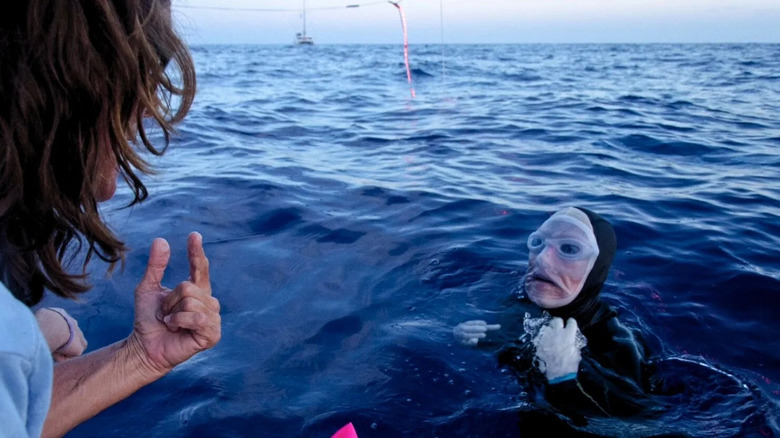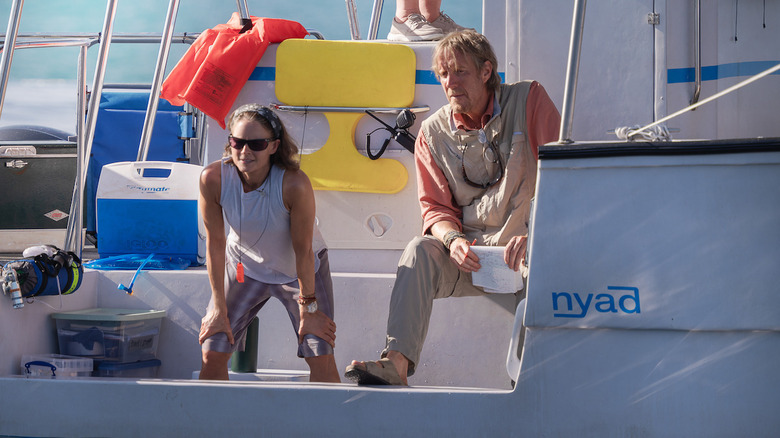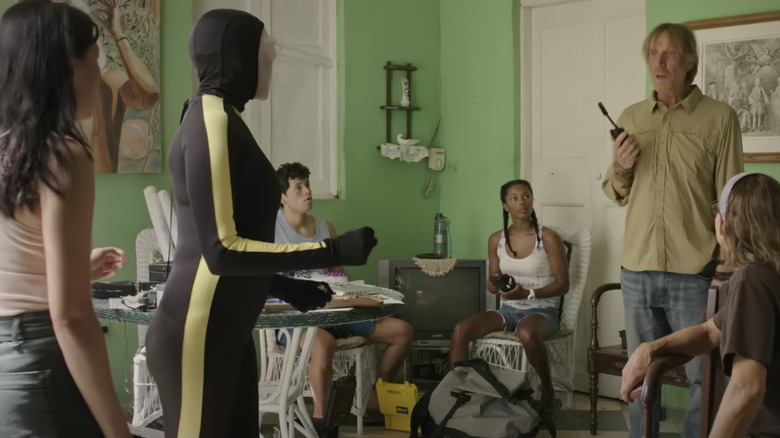Everything Nyad Gets Right And Wrong About The True Story
Contains spoilers for "Nyad"
The filmmaking duo behind the 2023 Netflix release, "Nyad," isn't new to true-to-life storytelling about extraordinary athletic abilities. Directors Elizabeth Chai Vasarhelyi and Jimmy Chin previously collaborated on the 2018 mountain climbing documentary, "Free Solo," and won an Academy Award for their efforts. But that was a documentary. "Nyad" marks their first foray into fictionalized material. The biopic is based on distance swimmer Diana Nyad's memoir, "Find a Way," which has, itself, been suspected of some degree of dramatization. As such, it can be difficult for the viewer to tell what in Vasarhelyi and Chin's movie is real and what's a convenient, creative invention ... even more so than the average narrative film inspired by real events.
With Annette Bening in the lead role, Oscar-winning cinematographer Claudio Miranda behind the camera, and Oscar-winning composer Alexandre Desplat on board, "Nyad" started generating awards buzz before it had even premiered. It's bold and commendable that the film centers around a 64-year-old semi-unlikable woman, and Bening is definitely relishing the opportunity to play Nyad in all of her complicated glory. However, "Nyad" has become controversial in the swimming community as well as among Hollywood punditry precisely because of its unreliable protagonist, and what the movie insinuates versus what it omits. Whether "Nyad" has value as an uplifting work of fiction despite its inconsistencies is ultimately in the eye of the beholder. And, like most biopics, this more fanciful version of the story is still built on a basic framework of truth. This is where "Nyad" swims straight, and where it goes off course.
Diana Nyad's accomplishments have come under scrutiny
To casual sports observers, Diana Nyad's reputation looms large in the world of extreme long-distance swimming. Though it's a niche sport, at least some percentage of Netflix subscribers had probably heard of her before they clicked play on the biopic about her supposedly historic swim. The film opens and closes with real footage of Nyad, both in the water and in TV appearances, as broadcasters rattle off a list of her accomplishments, including her record-breaking swims from Capri to Naples and around the island of Manhattan.
But to the athletes who actually compete in open water marathon swims, she's a highly controversial figure. That's because she's been caught exaggerating or outright fabricating details about her swimming career. There's even a website dedicated to debunking the mythology she's built around herself (or so its proprietors claim). Nyadfactcheck.com disputes her assertions that she ever won a national swimming event, broke a world record, or participated in the Olympic trials. It also takes issue with some of her more qualitative statements, such as the idea that she was "the best ocean swimmer in the world."
Nyad did own up to her tendency to embellish the truth in an interview with the Los Angeles Times. "Am I embarrassed to have inflated my own record when my record is pretty good on its own? Yes, it makes me cringe," she said. The film hints at her self-aggrandizing with anecdotes about, for example, her sponsorship deals, but it doesn't address any of the mistruths about her swimming resume head-on.
Her stepfather was an ominous presence in her life
Though her multiple attempts to swim from Havana, Cuba to the Florida Keys make up the main plot of "Nyad," the title character's personal life plays out in the background and in flashbacks. A thematic subplot involves who we're told is her father, Aristotle Nyad. Aristotle is a Greek immigrant who doesn't so much encourage as insist upon greatness from Diana. She repeatedly mimics him explaining that her last name means water nymph, to her best friend and coach Bonnie's dismay. As the film progresses, we see that Aristotle was a volatile presence in her home and that he eventually left. Near the conclusion, Diana reveals that he wasn't even really her biological father, and that she isn't actually Greek. Her origin story is yet another part of her personal myth-making.
In real life, Diana's biological father died when she was a baby, and her mother re-married Aristotle less than three years later. He formally adopted her and instilled in her a love of competitive swimming, so much so that he moved the family to Florida where she became more serious about her training. Diana didn't find out that Aristotle was her stepfather and not her father until she was about 11 years old. In her book, "Find a Way," Nyad claims that Aristotle began sexually abusing her around the same time. This allegation isn't hinted at or depicted in the movie about her life, though his domestic violence is.
If you or anyone you know has been a victim of sexual assault, help is available. Visit the Rape, Abuse & Incest National Network website or contact RAINN's National Helpline at 1-800-656-HOPE (4673).
She and Bonnie didn't have a falling out
The heart of "Nyad" isn't the protagonist's incredible swimming, it's the incredibly strong and supportive relationship between Diana Nyad and Bonnie Stoll (Jodie Foster). In the film, we see that Diana and Bonnie have an intimate albeit platonic relationship (they're both lesbians; Bonnie says they dated for "about a second 200 years ago"). Diana's a semi-famous distance swimmer who's been retired for more than 30 years. Bonnie's a former racquetball champ who still works as a professional trainer. When Diana recommits herself to completing the Cuba to Florida swim, she asks Bonnie to be her coach. Bonnie's not a swimmer, but she is a world-class motivator, and she dedicates herself to helping her best friend achieve her close-to-impossible goal.
But four tries and several near-death experiences later, Bonnie throws in the towel. She doesn't want to watch her friend die chasing her dream. She comes around, however, just before the conditions are right for Diana to give Cuba to Florida one last go. When her friend finally gets her ankles out of the water, Bonnie is the first person she embraces.
Most of that's true ... except for the rift that happens between Diana and Bonnie in between the fourth and fifth swims. The real Stoll told USA Today that filmmakers added that element to ramp up the tension before the climax. Though the two did take about a five-month break in their working relationship, it was always understood that Stoll was going to return as Nyad's coach.
She has been outspoken about her coach's abuse
As Diana Nyad physically wrestles with waves and wildlife in the present, she psychologically struggles with the trauma from her past, which the audience sees in recreated flashback scenes that unfold like snippets of memories. A 14-year-old Diana becomes awkward when her coach, Jack Nelson (Eric T. Miller), notices that she's scribbled his name on her notebook. Nelson pushes the obviously talented teenage Diana to dream big — Olympic big — but he also controls her by telling her that if she doesn't acquiesce to his every command, those dreams will never come true. When Nelson suggests that she go take a nap in a guest room, the camera cuts away just before the moment he molests her. But the abuse is more than implied, especially when a violated Diana redresses in front of a mirror, in tears.
Adult Diana discusses these assaults and the toll they took on her with Bonnie, and archival footage of the real Diana Nyad speaking about it publicly is edited into the film as well. The swimmer first told someone about Nelson's abuse when she was about 21, and she has continued to write and speak about her experiences ever since. In a 2017 essay for The New York Times, Nyad detailed the extent of what she endured and what happened after she went public with her story. Despite the fact that another athlete came forward with a corroborating account, Nelson was never held accountable and went on to have a hall-of-fame career.
If you or anyone you know has been a victim of sexual assault, help is available. Visit the Rape, Abuse & Incest National Network website or contact RAINN's National Helpline at 1-800-656-HOPE (4673).
There wasn't really a shark attack
In the film, we see that Diana Nyad used a shark cage for her maiden voyage in 1978. She blames her failure in part on the cage as well as the navigator she hired. But the waters are no less shark-infested in 2010, so Bonnie begins searching for a solution.
She finds one in Shark Shields and the team that will deploy them as Diana makes her way from Havana to the Keys. Early on in "Nyad," the characters and the audience are treated to a demonstration when one of the employees jumps into the water after he dumps out a bloody bucket of chum. Devices submerged in the water produce an electronic deterrent that supposedly keeps the creatures at bay, thanks to the short-range receptors in their nostrils. It works well enough that Diana and Bonnie buy into the idea. Then, just when things are finally going well for Diana, the crew spots a dorsal fin in the open ocean. It's charging at them and the Shark Shields aren't doing anything to stop it. Finally, the control box flickers on, and the shark is scared off at the last moment.
There were certainly sharks in the water with the real Diana Nyad, and her team did rely on Shark Shields (which are only modestly effective). A member of her crew told Slate that there were "three oceanic whitetips, two very large hammerheads" and what might've been an eight-foot bull shark following her at various points throughout her journey. But this close encounter in which Diana was almost attacked because of a mechanical failure did not happen.
She really was stung by jellyfish and man o' war
Sharks might be scarier to most people who visit the ocean, but the more realistic threat for Diana Nyad is the prevalence of jellyfish and Portuguese man o' war, whose stings, the film tells us, can be debilitating and potentially fatal. Her worst nightmare comes to pass during her third attempt to swim from Cuba to Florida. Diana starts screaming, "Fire!" and her team realizes that something's wrong. A doctor, Angel Yanagihara (Jeena Yi), later examines Diana and warns Bonnie that the effects of the box jellyfish that stung her are cumulative. In other words, she shouldn't get stung again. The concern is grave enough that Yanagihara joins the team, and a seal-like suit as well as a surely uncomfortable mask are designed to keep her safe. That suit and mask become important parts of the real Diana Nyad's story.
These events occurred, more or less, as shown. Diana Nyad was pulled from the water more than 60 hours into her third attempt, in September 2011, after she sustained box jellyfish and man o' war stings that caused her to have respiratory problems and seized muscles. She was stung again — nine times, on her face, neck, and hands — during her fourth attempt in August 2012. Nyad was right to take precautions. Though fatal box jellyfish and man o' war stings are rare, they aren't unheard of.
Her successful fifth attempt has never been ratified
The most controversial thing about "Nyad" is how it frames the significance of Diana Nyad's famous — and some would say infamous — swim. After she reaches shore on her fifth try, the mood is unabashedly celebratory and the audience is left with the understanding that Diana has, in no uncertain terms, achieved her lofty goal. The truth isn't nearly so simple.
The real Diana Nyad's swim has never been ratified by the World Open Water Swimming Association or the Marathon Swimmers Foundation (via Swim Swam). That means it doesn't officially count. Her feat was even retracted from the Guinness Book of World Records. Bodies like WOWSA and MSF that regulate extreme open water swimming mandate that, for swims to count as unassisted, swimmers cannot make use of special suits or other equipment, and they can't come into contact with their guide boat or anyone on their team. Diana required the help of her coach and crew several times during her Cuba to Florida course, especially when it came to getting her disqualifying protective suit on and off.
Diana has argued that, because what are commonly referred to as the English Channel rules didn't exist when she completed her swim, those standards shouldn't be held against her. Nevertheless, she's willing to have her accomplishment ratified as "assisted." WOWSA ultimately denied her request, however, and to some of her critics, troubling questions remain unanswered. A nine-hour gap in her log books as well as a lack of complete video evidence has cast doubt over her otherwise impressive accomplishment.
John Bartlett died shortly afterwards
One of the aces that Diana Nyad has up her sleeve in her 60s that she didn't have in her 20s is John Bartlett (Rhys Ifans), a salt-of-the-earth navigator who proves to be invaluable to the ambitious swimmer. Diana is used to knowing everything (or at least thinking she does), but she comes to rely on Bartlett's wisdom as it pertains to ocean currents and life. Bonnie Stoll and Bartlett forge a friendship along the way, too. The film hits a somber note when he reveals to Bonnie that he's sick, and the implication is it's something terminal. He considers Diana's fifth swim his last adventure.
"Nyad" doesn't contain a title card that references John Bartlett's death, but he did pass away on December 10, 2013, mere months after he helped Diana complete her swim. No cause of death is listed in his obituary, but Nyad wrote in her book, upon which the movie is based, that he succumbed to heart failure in his sleep. It's possible he knew that he had heart disease, but to the outside world, his death at age 66 was unexpected. Research into Nyad's swim revealed that Bartlett didn't use "conventional medicine for an underlying condition" (via WOWSA), so something like the scene on the boat may have taken place. Another minor inconsistency from his obituary: Bartlett accompanied Nyad beginning with her third swim, not her second.
She wasn't the first person to swim from Cuba to Florida
There's a moment in the middle of "Nyad" when a younger swimmer, Chloe McCardel, endeavors to complete the Cuba to Florida swim, too. Diana and Bonnie watch her progress on TV and track her GPS on a laptop. They're thrilled when she goes dark and eventually throws in the towel. The film leaves the audience with the impression that Diana Nyad not only set a record but was the first person to complete this particular open-water course. One of the main points of contention between Diana Nyad and the distance swimming world is the fact that she frequently neglects to mention that she was actually the third person to make it from Cuba to the Keys.
A man named Walter Poenisch was the first swimmer to make it from Cuba to the Florida Keys in 1978. He completed his 128.8 mile swim in 34 hours and 15 minutes when he was 65 years old. Susie Maroney became the first woman to do so in 1997, when she made a 111-mile journey in 24 hours and 31 minutes. She was 22 years old at the time. Both Poenisch and Maroney made use of shark cages and accepted the fact that their swims were categorized as assisted because of this so-called safety measure. Poenisch also made contact with his boat. Unfortunately, part of Nyad's legacy is that after she abandoned her 1978 swim, she was unnecessarily cruel to Poenisch in the press.
Her swims were a team effort
In the rousing resolution of "Nyad," the headstrong and arrogant distance swimmer stands on the sand and declares that she has three things to say. The first and second sentiments are that you should never give up and you're never too old to follow your dreams. The third is that, though marathon swimming looks like a solo effort, it's actually a team sport. Diana finally acknowledges the contributions of her team as the music swells and the film transitions to the credits. The end of the real swim really did unfold almost exactly as it does in the movie. But, though we've only seen one boat trailing Diana as she freestyles her way through the treacherous water, a title card reads, "Forty people, accompanying her on boats alongside Voyager, witnessed her incredible feat." What the postscript doesn't make clear is that those boats were also part of her team and not just spectators.
A support crew of 40 people on four boats served the real Diana Nyad in various capacities. According to screenwriter Julia Cox (via Vanity Fair), they were composited into a handful of characters for the sake of narrative economy. But that also means that 40 people saw Diana Nyad swim from Havana to the Keys, and in the filmmakers' and the subjects' opinions, that means upwards of 40 people would have to be willing to cover for her if the movie's prickly heroine didn't really do what she claims to have done over those 53 hours in 2013.
